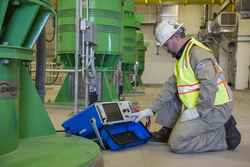
Posted to News on 6th Sep 2017, 12:33
Partial discharge testing to improve electric motor reliability
SKF has incorporated advanced partial discharge test capabilities into its Baker DX range of Static Motor Analysers. That's helping manufacturers, operators and service providers to spot subtle problems that could lead to big reliability issues

Most electrical problems in motors and generators start with insulation problems. Insulation damage that begins with small manufacturing defects, contamination, excess heat or wear can rapidly develop into major issues that shut down critical machinery. That's why static electrical testing is widely used as part of the modern condition-based approach to motor maintenance.
There's one category of problem that is particularly difficult to identify using conventional testing methods, however. A Partial Discharge (PD) is a small electrical discharge caused by the ionisation of oxygen in the presence of a high voltage electrical field. In motors, Partial Discharge can occur when bubbles or other manufacturing imperfections create an air gap between a winding conductor and its surrounding insulation. The resulting ozone is corrosive to many common insulation materials and, over time, PD effects can lead to complete breakdown of the insulation and failure of the motor.
Partial Discharge was once mainly a concern to manufacturers and users of high-voltage equipment, but the widespread use of variable speed drives to improve the performance and efficiency of low-voltage motors means these systems are often exposed to many more of the transient high-voltage peaks that can lead to PD events, and eventually to motor failure.
The challenge during testing is that the discharge happens very quickly, usually in just a few nanoseconds, as the winding experiences high-voltage transients. Conventional test equipment doesn't sample rapidly enough to capture these short, transient effects.
SKF's latest generation of motor analysers, like the Baker DX range, however, are equipped with new, ultra-high speed analogue to digital convertor technology that can capture the high-frequency component of the signal generated during the surge test. Smart software algorithms then separate the high frequency component from the low frequency impulse waveform, allowing the presence of PD events to be measured and their magnitude calculated.
Trending test results on the same equipment over time gives users a clear and straightforward indication of how the PD inception and extinction voltages are decreasing. When these voltage levels fall into the range of the normal voltage transients seen by the motor, the weakening of the insulation will accelerate. For manufacturers and service providers, that provides greater assurance that equipment will perform reliably in service. For operators, an earlier warning of potential problems improves maintenance planning, reducing costly downtime or unscheduled loss of production. SKF's desktop software package, Surveyor DX, has been updated to store, display and trend the partial discharge results, as well as the other standard tests offered by the DX analysers.
Go to www.skf.com to learn more about the Baker DX range of Static Motor Analysers from SKF.






























